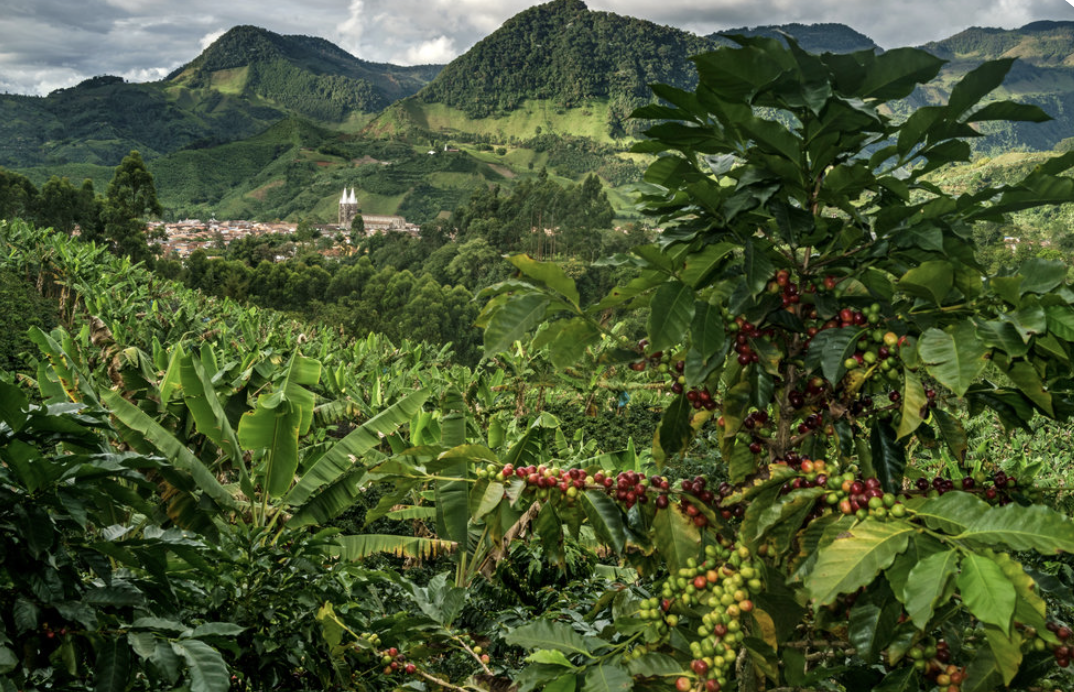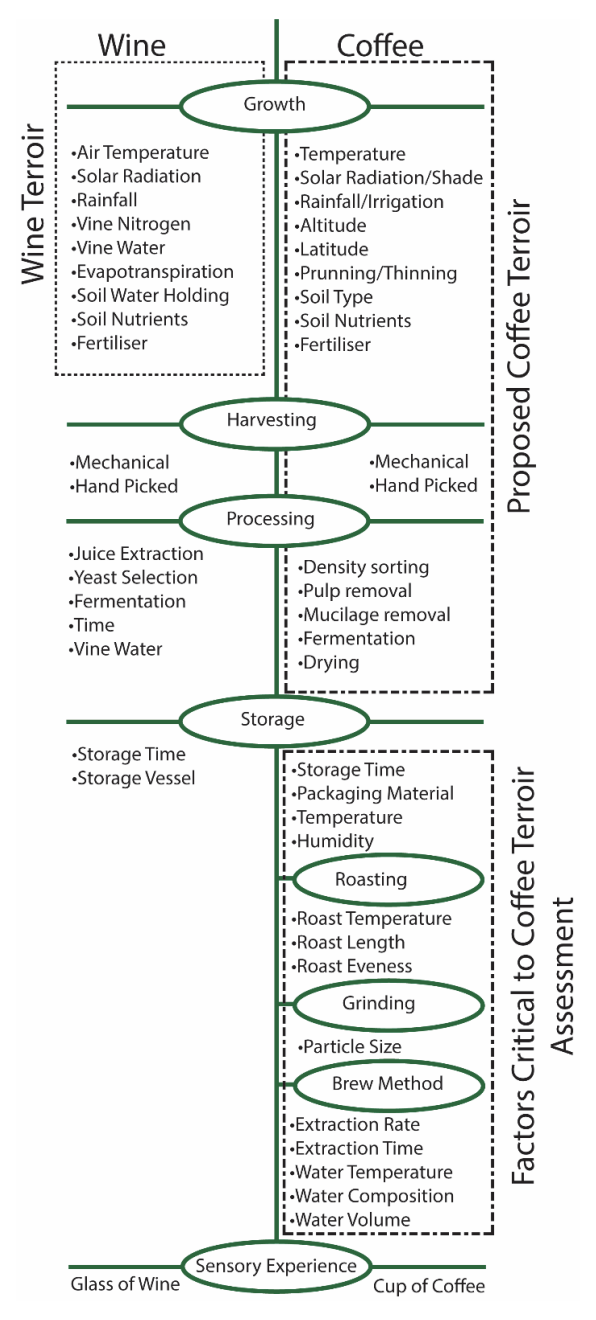TERROIR
WHY COFFEE IS (NOTHING) LIKE WINE…
WHY COFFEE IS (NOTHING) LIKE WINE…
|

I. TERROIR MATTERS
|

| Wine terroir is widely recognised, with the location of the vineyard believed to influence the sensory properties of a wine. Factors such as air temperature, solar radiation, rainfall, soil water-holding capacity and nitrogen are related to locations and contribute significantly to wine terroir.
Terroir in coffee is most evident in coffees that represent their growing location; e.g. CUPRIMA’s TERRA Coffees -The focus in this category is on the terroir, the coffee that best represents the organoleptic profile of its region. These coffees are available all year round and traceable up to the region. |

Like the terroir of wine, the terroir of coffee is influenced by environmental factors such as latitude, longitude, rainfall, temperature and altitude.It has been reported that terroir associated with high altitude (>1000 m) and low rainfall (<1600 mm/year) produced a more prized coffee that was aromatic, slightly bitter, acidic and had body. In contrast, coffee grown at low altitude (<850 m) and high rainfall (>2110 mm/year) was less valued, with more substantial bitterness, grassy flavour, lower aroma and increased astringency.A terroir with high altitude reportedly produces favourable higher-quality coffee. It is believed that higher altitude with lower average temperature extends the ripening period of coffee berries, resulting in a nutritionally dense coffee bean that provides a greater concentration of chemicals/taste to the resulting coffee drink. |
II. BEYOND TERROIR
Based on the terroir definition of wine, the terroir is fixed as soon as the coffee berry is harvested. However, compared to wine, coffee undergoes more steps in its production journey that can influence the final sensory experience. The impact of processing method, roasting level and brewing method on the final sensory experience is well documented and has recently been assessed. As these steps affect the final sensory experience, they have a significant impact on the terroir experience and assessment. Observation of coffee terroir is possible when the steps of roasting, grinding and brewing are standardised.
Furthermore, compared to wine, post-harvest processing of coffee often takes place under uncontrolled environmental conditions. E.g. sun-dried and monsoon Malabar represent post-harvest processing methods that are particularly dependent on the environment. Since the environment still influences processing steps, it should be considered whether coffee terroir includes this step.
Coffee terroir broadly includes those factors that influence the growth of the coffee berry and its conversion into a green coffee bean. However, the assessment of coffee terroir depends on the steps that convert the green coffee bean into a cup of coffee. This assessment aims to identify and bring together the factors that determine terroir and the factors that influence terroir assessment. The identification of terroir starts with the quality of the cup of coffee. This assessment works from the cup to the farm to assess the factors that influence the terroir of coffee.

A comparison of the steps required before the terroir of wine or coffee is assessed, with wine terroir defined and coffee terroir proposed – source ‘Does Coffee Have Terroir and How Should it Be Assessed?‘
| Vintners maintain that wine is made in the vineyard, and they’re not being coy. The same concept applies to coffee. Quality starts with farming practices. For a long time, quantity was favored over quality, as pickers were paid by the weight of beans harvested. Education and training have taught farmers skills like identifying cherry ripeness, sorting, pruning and processing, as well as pest and water management. And similar to grapes, bad weather can wipe out an entire year’s crop.
Roasting coffee is akin to the influence of a wine’s barrel aging. A winemaker that ages Pinot Noir in a heavily charred barrel for 24 months sacrifices bright fruit for smoky, toasty, vanilla notes. The latest term in oak usage is “judicious,” recognizing when barrel aging enhances and supports a wine, but doesn’t smother it. Coffee that’s roasted judiciously highlights unique flavors. For a long time, consumers wanted “strong” and “bold” brews, synonyms for dark, oily, heavily charred beans. However, the availability of better coffees has driven the adoption of lighter roast styles and helped change consumer preferences. |
This entire long and demanding expedition behind taste tones concludes, as usual, with a cup of delicious coffee. Of course, the methods of its preparation already depend on the personal preferences of each one of us and the taste we want to achieve in the cup. Some like the intense tastes of espresso , others like the more traditional taste of moka coffee or French press. The younger generation, on the other hand, prefers alternative methods such as Aeropress or V60.

III. HOW TO ASSESS TERROIR
|
IV. TRANSMISSION OF TERROIR
Fine wine is valued for its ability to transmit specificity of place that can include geography, soil, climate and weather patterns. Wine appellations attempt to identify and protect these differences, and provide quality standards. While specialty coffee has identifiable regional characteristics, no formal appellation system yet exists.
Ethiopia, for example, has quality and character recognition for its beans from Harar (known for exuberant fruit aromatics, especially blueberry) and Yirgacheffe (known for vibrant acidity, citrus and floral notes).
Promoting terroir to market coffee is a fairly recent concept. These days, most consumer coffees are labeled by their country of origin, but are increasingly noting specific regions and farms. The uptick in “micro-lots”—coffees from exceptional beans separated from the larger harvest—shows promise in identifying special sites, much like single-vineyard wines.

V. CLIMATE CHANGE IS TWEAKING TERROIR
Climate is a major factor in terroir. It is clear that the climate emergency is having a seismic impact on both industries. While changing weather patterns are causing drought in Ethiopia, erratic rainfall in Brazil is damaging flowers and impeding fruit maturation. Meanwhile, higher temperatures, flooding and subsequent increase in exposure to fungi and bacteria are creating hardship for wine producers in California, Australia, Spain, and Italy.
Climate change is forcing farmers and agricultural entrepreneurs to adapt and embrace new crops that would have been impossible for them to grow even 10 years ago. New terroirs could forever change the way we think of the heritage and provenance of wine or coffee. World Coffee Research – a global, joint R&D program – investigates climate resilience, among other things.
Wine has seen strong growth in more northerly geographies, which are increasingly able to grow highly esteemed grape varieties due to temperature rises. According to National Geographic, the best areas for growing coffee are expected to shift away from the tropics.
